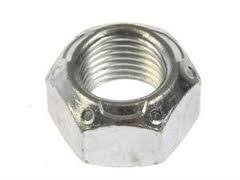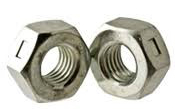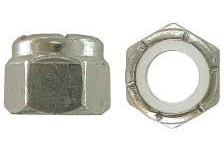Part four of our series on fastener locking methods will delve into lock nuts, also referred to as prevailing torque nuts because they are not “free spinning” but require a prevailing torque to assemble them.
Many different styles of locking nuts have been developed over the years, but we will focus on two general categories: all metal lock nuts and nylon insert lock nuts.
All Metal Lock Nuts
All metal lock nuts start their life as free spinning nuts but pass through either a press or punch machine which deforms part of the thread to create friction during assembly. Classified as either top lock or side lock, it is a good idea to know the difference and determine the best style for your application.
Top Lock
Top lock nuts have a thread deformation at one end of the nut, meaning assembly can only take place in one direction. The most common type of top lock nut (often referred to as a stover lock nut) has a cone shape on top, making it easy to identify the top of the nut for directional assembly.

Side Lock
Two-way lock nuts may be assembled in either direction, which allows them to be used in automated assembly. These nuts can be identified by the punch marks on the flats. It is common to have either one punch mark, or two punch marks on opposing flats.

Nylon Insert Nuts
Nylon insert nuts use a non-threaded nylon ring which gets crimped into the top of the nut at the end of the manufacturing process. As the nut is assembled onto a bolt, threads form into the nylon ring at the top of the nut, creating resistance.

Each style of nut has its advantages and disadvantages. All metal lock nuts can be used at higher temperatures than nylon insert nuts, but nylon insert nuts tend to have more consistent clamp load from lot to lot. All metal lock nuts typically require a wax on top of the normal zinc plated finish to keep from galling, which can result in some unpredictable clamp loads in critical joints.
For more information on locking nuts, check out www.bossard.com or contact us at ProvenProductivity@bossard.com.
For more shopping options click here.
Doug Jones
Applications Engineer
djones@bossard.com




